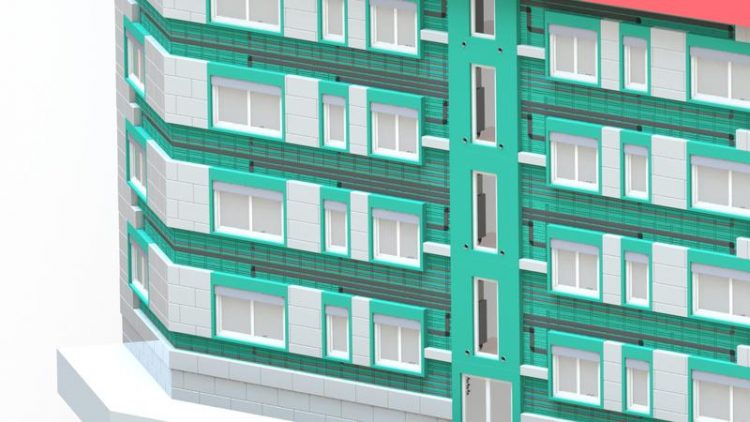Flexible and Functional – Prefabricated Façade Elements Simplify Building Renovation

Model shows the wiring and pipes integrated in the façade of a demonstration building from the 1950s in Frankfurt, Germany. ©Fraunhofer ISE
The multi-functional insulation boards and window elements can be implemented in new buildings as well as buildings undergoing renovation. The type of materials used and the integration technique can be combined according to the customer’s wishes. The prefabricated façade and window elements are the first results stemming from several research projects in which Fraunhofer ISE is involved.
It has been shown that the use of these elements increases the building’s energy efficiency.
Reducing energy consumption and boosting energy efficiency are important prerequisites to achieve a climate neutral building stock, the aim of the German federal government by 2050. The political ambitions are high, yet the current renovation rate is very low. Flexible and cost-effective solutions are lacking. Together with industry partners the experts at Fraunhofer ISE have been working on developments over the past years to combine the renovation of the building envelope with the optimization of the HVAC systems.
Now they present their first prefabricated element developed within the project “Retrokit” (http://www.ise.fraunhofer.de/en/business-areas/solar-thermal-technology/research…). The element consists of multi-functional insulation boards and prefabricated window elements. The construction allows different materials to be combined together. “Depending on the fire safety regulations, insulation materials such as foam or mineral wool can be combined with ventilation ducts made of plastic or metal,” explains Fabien Coydon of Fraunhofer ISE.
The technical components of ventilation, heating, sanitation pipes or electrical and ICT wiring can be integrated in the thermal panels. These façade elements are especially suitable for existing and older buildings. Their use will soon be demonstrated for the first time in a building from the 1950s in Frankfurt, Germany.
One of the biggest advantages of these multi-functional façade elements is that they are installed outside on the façade. Therefore, the inhabitants experience less disrupted during renovation. Also, the installation time required is reduced. To install the element, the window elements are first mounted onto the façade and subsequently a first layer of insulation with integrated channels.
The ducts or pipes for the building technology services and the sanitation system are then installed using a simple click system. Afterwards a second layer of insulation is installed and the exterior plaster is applied. Finally the old windows are removed from inside. “We see here a large potential because the concept and installation procedure enable a fast, cost-effective and high quality renovation,” says Coydon.
“And the need is high, since residential buildings from the post-war era through to the 80s urgently require an energy retrofit to meet today’s standards.” The multi-functional façades, the prefabricated window elements and the entire renovation concept developed by Fraunhofer ISE are protected by patents. Product marketing is possible through licensing contracts.
Meet our experts at the ISH in Frankfurt from the 10th -14th March 2015 in Hall 10.3, Booth C79!
http://www.ise.fraunhofer.de/en/business-areas/solar-thermal-technology/research… – Website “Retrokit”
http://www.ise.fraunhofer.de/en – Website Fraunhofer ISE
Media Contact
All latest news from the category: Architecture and Construction
Newest articles

NASA: Mystery of life’s handedness deepens
The mystery of why life uses molecules with specific orientations has deepened with a NASA-funded discovery that RNA — a key molecule thought to have potentially held the instructions for…

What are the effects of historic lithium mining on water quality?
Study reveals low levels of common contaminants but high levels of other elements in waters associated with an abandoned lithium mine. Lithium ore and mining waste from a historic lithium…

Quantum-inspired design boosts efficiency of heat-to-electricity conversion
Rice engineers take unconventional route to improving thermophotovoltaic systems. Researchers at Rice University have found a new way to improve a key element of thermophotovoltaic (TPV) systems, which convert heat…



